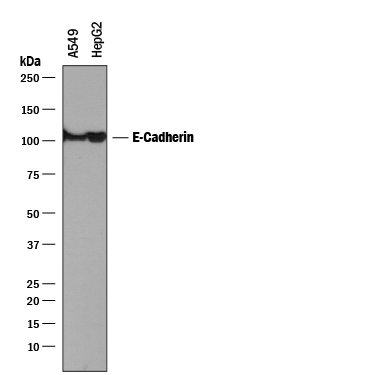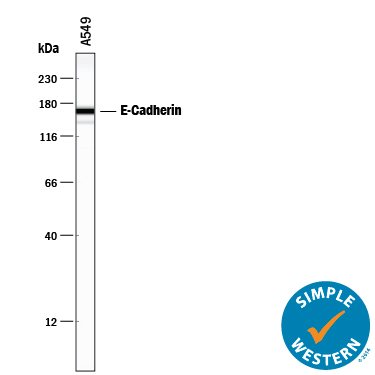Human E-Cadherin Antibody Summary
Asp155-Ile707
Accession # P12830
Applications
Please Note: Optimal dilutions should be determined by each laboratory for each application. General Protocols are available in the Technical Information section on our website.
Scientific Data
 View Larger
View Larger
Detection of Human E‑Cadherin by Western Blot. Western blot shows lysates of A549 human lung carcinoma cell line and HepG2 human hepatocellular carcinoma cell line. PVDF membrane was probed with 0.5 µg/mL of Mouse Anti-Human E-Cadherin Monoclonal Antibody (Catalog # MAB1838) followed by HRP-conjugated Anti-Mouse IgG Secondary Antibody (Catalog # HAF018). A specific band was detected for E-Cadherin at approximately 110 kDa (as indicated). This experiment was conducted under reducing conditions and using Immunoblot Buffer Group 1.
 View Larger
View Larger
E-Cadherin in Human Colon. E-Cadherin was detected in immersion fixed paraffin-embedded sections of human colon using Mouse Anti-Human E-Cadherin Monoclonal Antibody (Catalog # MAB1838) at 2 µg/mL overnight at 4 °C. Tissue was stained using the Anti-Mouse HRP-DAB Cell & Tissue Staining Kit (brown; Catalog # CTS002) and counterstained with hematoxylin (blue). Specific labeling was localized to the plasma membrane of epithelial cells. View our protocol for Chromogenic IHC Staining of Paraffin-embedded Tissue Sections.
 View Larger
View Larger
Detection of Human E‑Cadherin by Simple WesternTM. Simple Western lane view shows lysates of A549 human lung carcinoma cell line, loaded at 0.2 mg/mL. A specific band was detected for E‑Cadherin at approximately 166 kDa (as indicated) using 5 µg/mL of Mouse Anti-Human E‑Cadherin Monoclonal Antibody (Catalog # MAB1838). This experiment was conducted under reducing conditions and using the 12-230 kDa separation system.
Reconstitution Calculator
Preparation and Storage
- 12 months from date of receipt, -20 to -70 °C as supplied.
- 1 month, 2 to 8 °C under sterile conditions after reconstitution.
- 6 months, -20 to -70 °C under sterile conditions after reconstitution.
Background: E-Cadherin
Epithelial (E) - Cadherin (ECAD), also known as cell-CAM120/80 in the human, uvomorulin in the mouse, Arc-1 in the dog, andL-CAM in the chicken, is a member of the Cadherin family of cell adhesion molecules. Cadherins are calcium-dependent transmembrane proteins which bind to one another in a homophilic manner. On their cytoplasmic side, they associate with the three catenins, alpha, beta, and gamma (plakoglobin). This association links the cadherin protein to the cytoskeleton. Without association with the catenins, the cadherins are non-adhesive. Cadherins play a role in development, specifically in tissue formation. They may also help to maintain tissue architecture in the adult. E-Cadherin may also play a role in tumor development, as loss of E-Cadherin has been associated with tumor invasiveness. E-Cadherin is a classical cadherin molecule. Classical cadherins consist of a large extracellular domain which contains DXD and DXNDN repeats responsible for mediating calcium-dependent adhesion, a single-pass transmembrane domain, and a short carboxy-terminal cytoplasmic domain responsible for interacting with the catenins. E-Cadherin contains five extracellular calcium-binding domains of approximately 110 amino acids each.
- Bussemakers, M.J.G. et al. (1993) Mol. Biol. Reports 17:123.
- Overduin, M. et al. (1995) Science 267:386.
- Takeichi, M. (1991) Science 251:1451.
Product Datasheets
Citations for Human E-Cadherin Antibody
R&D Systems personnel manually curate a database that contains references using R&D Systems products. The data collected includes not only links to publications in PubMed, but also provides information about sample types, species, and experimental conditions.
13
Citations: Showing 1 - 10
Filter your results:
Filter by:
-
Candida albicans translocation through the intestinal epithelial barrier is promoted by fungal zinc acquisition and limited by NF?B-mediated barrier protection
Authors: Sprague, JL;Schille, TB;Allert, S;Trümper, V;Lier, A;Gro beta mann, P;Priest, EL;Tsavou, A;Panagiotou, G;Naglik, JR;Wilson, D;Schäuble, S;Kasper, L;Hube, B;
PLoS pathogens
Species: Human hepegivirus
Sample Types: Cell Lysates
Applications: Western Blot -
Integrating Oxygen and 3D Cell Culture System: A Simple Tool to Elucidate the Cell Fate Decision of hiPSCs
Authors: RR Khadim, RK Vadivelu, T Utami, FG Torizal, M Nishikawa, Y Sakai
International Journal of Molecular Sciences, 2022-06-30;23(13):.
Species: Human
Sample Types: Whole Cells
Applications: ICC -
Neutrophil extracellular traps (NETs) contribute to pathological changes of ocular graft-vs.-host disease (oGVHD) dry eye: Implications for novel biomarkers and therapeutic strategies
Authors: S An, I Raju, B Surenkhuu, JE Kwon, S Gulati, M Karaman, A Pradeep, S Sinha, C Mun, S Jain
Ocul Surf, 2019-04-06;0(0):.
Species: Human
Sample Types: Cell Lysates
Applications: Western Blot -
High content screening identifies monensin as an EMT-selective cytotoxic compound
Authors: M Vanneste, Q Huang, M Li, D Moose, L Zhao, MA Stamnes, M Schultz, M Wu, MD Henry
Sci Rep, 2019-02-04;9(1):1200.
Species: Human
Sample Types: Cell Lysates
Applications: Western Blot -
Selective Laminin-Directed Differentiation of Human Induced Pluripotent Stem Cells into Distinct Ocular Lineages
Authors: S Shibata, R Hayashi, T Okubo, Y Kudo, T Katayama, Y Ishikawa, J Toga, E Yagi, Y Honma, AJ Quantock, K Sekiguchi, K Nishida
Cell Rep, 2018-11-06;25(6):1668-1679.e5.
Species: Mouse
Sample Types: Whole Tissue
Applications: IHC-Fr -
Zeylenone represses the progress of human prostate cancer by downregulating the Wnt/??catenin pathway
Authors: S Zeng, B Zhu, J Zeng, W Wu, C Jiang
Mol Med Rep, 2018-10-17;0(0):.
-
Modeling of Aniridia-Related Keratopathy by CRISPR/Cas9 Genome Editing of Human Limbal Epithelial Cells and Rescue by Recombinant PAX6 Protein
Authors: LN Roux, I Petit, R Domart, JP Concordet, J Qu, H Zhou, A Joliot, O Ferrigno, D Aberdam
Stem Cells, 2018-07-18;0(0):.
Species: Human
Sample Types: Whole Cells
Applications: ICC -
Rose Bengal acetate photodynamic therapy (RBAc-PDT) induces exposure and release of Damage-Associated Molecular Patterns (DAMPs) in human HeLa cells.
Authors: Panzarini, Elisa, Inguscio, Valentin, Fimia, Gian Mar, Dini, Luciana
PLoS ONE, 2014-08-20;9(8):e105778.
Species: Human
Sample Types: Cell Fraction
Applications: Western Blot -
Progression of oral squamous cell carcinoma accompanied with reduced e-cadherin expression but not cadherin switch.
Authors: Hashimoto T, Soeno Y, Maeda G, Taya Y, Aoba T, Nasu M, Kawashiri S, Imai K
PLoS ONE, 2012-10-23;7(10):e47899.
Species: Mouse
Sample Types: Whole Cells
Applications: ICC -
Glycogene expression alterations associated with pancreatic cancer epithelial-mesenchymal transition in complementary model systems.
Authors: Maupin KA, Sinha A, Eugster E, Miller J, Ross J, Paulino V, Keshamouni VG, Tran N, Berens M, Webb C, Haab BB
PLoS ONE, 2010-09-27;5(9):e13002.
Species: Human
Sample Types: Cell Lysates
Applications: Western Blot -
Intratumoral induction of CD103 triggers tumor-specific CTL function and CCR5-dependent T-cell retention.
Authors: Franciszkiewicz K, Le Floc'h A, Jalil A, Vigant F, Robert T, Vergnon I, Mackiewicz A, Benihoud K, Validire P, Chouaib S, Combadiere C, Mami-Chouaib F
Cancer Res., 2009-07-28;69(15):6249-55.
Species: Human
Sample Types: Whole Cells
Applications: Flow Cytometry -
Vascular endothelial growth factor-A stimulates Snail expression in breast tumor cells: implications for tumor progression.
Authors: Wanami LS, Chen HY, Peiro S, Garcia de Herreros A, Bachelder RE
Exp. Cell Res., 2008-05-17;314(13):2448-53.
Species: Human
Sample Types: Whole Cells
Applications: Western Blot -
Expression of mesenchyme-specific gene HMGA2 in squamous cell carcinomas of the oral cavity.
Authors: Miyazawa J, Mitoro A, Kawashiri S, Chada KK, Imai K
Cancer Res., 2004-03-15;64(6):2024-9.
Species: Human
Sample Types: Whole Tissue
Applications: IHC-P
FAQs
No product specific FAQs exist for this product, however you may
View all Antibody FAQsReviews for Human E-Cadherin Antibody
Average Rating: 5 (Based on 1 Review)
Have you used Human E-Cadherin Antibody?
Submit a review and receive an Amazon gift card.
$25/€18/£15/$25CAN/¥75 Yuan/¥2500 Yen for a review with an image
$10/€7/£6/$10 CAD/¥70 Yuan/¥1110 Yen for a review without an image
Filter by:



